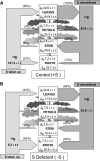Effect of mineral sulphur availability on nitrogen and sulphur uptake and remobilization during the vegetative growth of Brassica napus L
- PMID: 20403880
- PMCID: PMC2882259
- DOI: 10.1093/jxb/erq096
Effect of mineral sulphur availability on nitrogen and sulphur uptake and remobilization during the vegetative growth of Brassica napus L
Abstract
Because it has a high demand for sulphur (S), oilseed rape is particularly sensitive to S limitation. However, the physiological effects of S limitation remain unclear, especially during the rosette stage. For this reason a study was conducted to determine the effects of mineral S limitation on nitrogen (N) and S uptake and remobilization during vegetative growth of oilseed rape at both the whole-plant and leaf rank level for plants grown during 35 d with 300 microM (34)SO(4)(2-) (control plants; +S) or with 15 microM (34)SO(4)(2-) (S-limited plants; -S). The results highlight that S-limited plants showed no significant differences either in whole-plant and leaf biomass or in N uptake, when compared with control plants. However, total S and (34)S (i.e. deriving from S uptake) contents were greatly reduced for the whole plant and leaf after 35 d, and a greater redistribution of endogenous S from leaves to the benefit of roots was observed. The relative expression of tonoplast and plasmalemma sulphate transporters was also strongly induced in the roots. In conclusion, although S-limited plants had 20 times less mineral S than control plants, their development remained surprisingly unchanged. During S limitation, oilseed rape is able to recycle endogenous S compounds (mostly sulphate) from leaves to roots. However, this physiological adaptation may be effective only over a short time scale (i.e. vegetative growth).
Figures







Similar articles
-
Do initial S reserves and mineral S availability alter leaf S-N mobilization and leaf senescence in oilseed rape?Plant Sci. 2011 Mar;180(3):511-20. doi: 10.1016/j.plantsci.2010.11.008. Epub 2010 Nov 26. Plant Sci. 2011. PMID: 21421399
-
Do nitrogen- and sulphur-remobilization-related parameters measured at the onset of the reproductive stage provide early indicators to adjust N and S fertilization in oilseed rape (Brassica napus L.) grown under N- and/or S-limiting supplies?Planta. 2019 Dec;250(6):2047-2062. doi: 10.1007/s00425-019-03284-2. Epub 2019 Sep 25. Planta. 2019. PMID: 31555901
-
Nitrogen storage and remobilization in Brassica napus L. during the growth cycle: effects of methyl jasmonate on nitrate uptake, senescence, growth, and VSP accumulation.J Exp Bot. 2002 May;53(371):1131-41. doi: 10.1093/jexbot/53.371.1131. J Exp Bot. 2002. PMID: 11971924
-
Regulation of high-affinity sulphate transporters in plants: towards systematic analysis of sulphur signalling and regulation.J Exp Bot. 2004 Aug;55(404):1843-9. doi: 10.1093/jxb/erh175. Epub 2004 Jun 18. J Exp Bot. 2004. PMID: 15208340 Review.
-
Leaf senescence and nitrogen remobilization efficiency in oilseed rape (Brassica napus L.).J Exp Bot. 2014 Jul;65(14):3813-24. doi: 10.1093/jxb/eru177. Epub 2014 Apr 30. J Exp Bot. 2014. PMID: 24790115 Review.
Cited by
-
The impact of sulfate restriction on seed yield and quality of winter oilseed rape depends on the ability to remobilize sulfate from vegetative tissues to reproductive organs.Front Plant Sci. 2014 Dec 17;5:695. doi: 10.3389/fpls.2014.00695. eCollection 2014. Front Plant Sci. 2014. PMID: 25566272 Free PMC article.
-
Improving growth and productivity of Oleiferous Brassicas under changing environment: significance of nitrogen and sulphur nutrition, and underlying mechanisms.ScientificWorldJournal. 2012;2012:657808. doi: 10.1100/2012/657808. Epub 2012 May 1. ScientificWorldJournal. 2012. PMID: 22629181 Free PMC article.
-
Transcriptional and physiological changes in the S assimilation pathway due to single or combined S and Fe deprivation in durum wheat (Triticum durum L.) seedlings.J Exp Bot. 2013 Apr;64(6):1663-75. doi: 10.1093/jxb/ert027. Epub 2013 Feb 6. J Exp Bot. 2013. PMID: 23390290 Free PMC article.
-
ZIP Genes Are Involved in the Retransfer of Zinc Ions during the Senescence of Zinc-Deficient Rice Leaves.Int J Mol Sci. 2023 Sep 12;24(18):13989. doi: 10.3390/ijms241813989. Int J Mol Sci. 2023. PMID: 37762290 Free PMC article.
-
Specificity and Plasticity of the Functional Ionome of Brassica napus and Triticum aestivum Exposed to Micronutrient or Beneficial Nutrient Deprivation and Predictive Sensitivity of the Ionomic Signatures.Front Plant Sci. 2021 Feb 10;12:641678. doi: 10.3389/fpls.2021.641678. eCollection 2021. Front Plant Sci. 2021. PMID: 33643368 Free PMC article.
References
-
- Ahmad A, Abdin MZ. Interactive effect of sulphur and nitrogen on the oil and protein contents and on the fatty acids profiles of oil in the seeds of rapeseed (Brassica campestris L.) and mustard (Brassica juncea L. Czern. and Coss. Journal of Agronomy and Crop Science. 2000;185:49–54.
-
- Asare E, Scarisbrick DH. Rate of nitrogen and sulphur fertilizers on yield, yield components and seed quality of oilseed rape (Brassica napus L.) Field Crop Research. 1995;44:41–46.
-
- Bell CI, Clarkson DT, Cram WJ. Partitioning and redistribution of sulphur during S-stress in Macroptilium atropurpureu, cv. Siratro. Journal of Experimental Botany. 1995;46:73–81.
-
- Bell CI, Cram WJ, Clarkson DT. Turnover of sulphate in leaf vacuoles limits retranslocation under sulfur stress. In: de Kok LJ, Stulen I, Rennenberg H, Brunold CH, Rauser WE, editors. Sulfur nutrition and sulfur assimilation in higher plants. The Hague, The Netherlands: SPB Academic Publishing; 1990. pp. 3–11.
Publication types
MeSH terms
Substances
LinkOut - more resources
Full Text Sources
Medical

